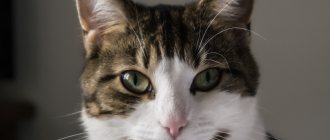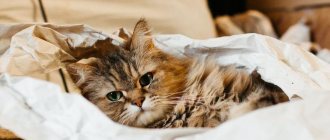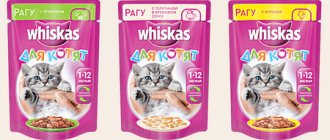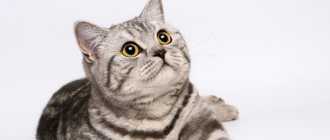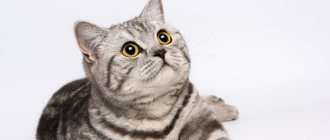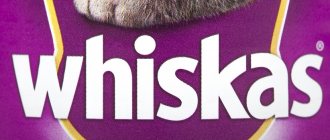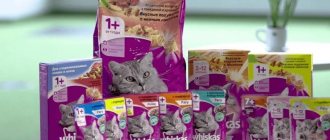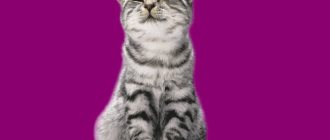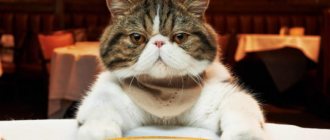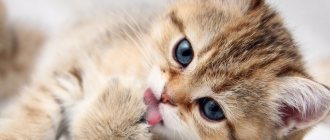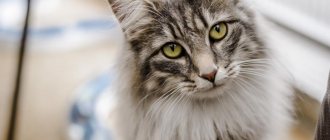July 16, 2016
Wiskas is a brand of cat food produced by Mars ink since 1958. The food first appeared in the UK and was produced by Pedigree Petfoods Ltd. in Melton Mowbray, where other popular foods were also produced: Chappie, Kitekat, Pedigree, Royal Canin. According to various sources, food appeared on our market in 1991. Bright advertising, availability on store shelves and the pleasure with which cats eat whiskey have made it very popular among animal lovers. We decided to figure out whether we are getting healthy food at a low price, or whether the proverb “free cheese is only in a mousetrap” justifies itself here too.
Almost all the reviews about Whiskas that we found on the Russian Internet are negative. Whiskas is blamed for diseases of the urinary system, enlargement of internal organs, diarrhea, dermatitis, cancer and the death of a pet. And the company itself is portrayed as the devil of the cat world, profiting from the lives of its beloved furry friends. However, is this really so? Having asked this question, we had to raise a lot of scientific information. Let's take a point-by-point look at why Whiskas feed is blamed, and what professionals working in the pet business think about it.
- A cat is a carnivore, and whiskey contains everything except meat.
This is true, we must not forget that whiskey is an economy class feed, and in its production, of course, fillet tenderloin will not be used. However, the composition includes slaughterhouse waste and offal, what remains from animals after all the most valuable things have been taken away for people. And there is no need to be afraid of this, as we have already learned above, a cat is a predator, and a predator in the wild does not have to choose. Everything that the prey carcass can digest goes into food: meat, bones, fur. However, this remark is relevant for “yard” breeds. As for purebred animals, you need to be very careful in choosing food, and whiskey would not be included in our recommendations.
- Whiskas contains a lot of vegetable proteins and carbohydrates that are not digested by the cat.
Science has learned to synthesize a complete protein suitable for cats in terms of amino acid composition. And it is its presence in food that replaces meat and makes food cheaper. There's nothing you can do about it, it's such a business. But as for carbohydrates, experts are still arguing about the ability of the cat’s body to absorb it in large quantities. According to recent data, the cat's ability to metabolize starch (carbohydrate) is underestimated.
- Whiskas contains corn or its gluten, and it causes cancer!
Cancer cells feed on carbohydrates, and the presence of corn protein (gluten) in the food does not affect the development of this disease. By the way, brands such as Royal Canin and Hills deliberately leave corn in their feed, and this may indicate its benefits rather than harm. But there is also another opinion that corn is a feed cheapener containing an excess amount of carbohydrate, which leads to obesity, pancreatitis, diabetes and liver disease.
- Whiskas contains flavor enhancers that are harmful to cats and cause addiction.
We are talking about a flavor and aroma additive that makes the food attractive. Here you need to understand that whiskey can be called a “synthetic” food, and of course the cat will not eat tasteless synthetics at will. This additive is contained in almost all feeds, except the most natural ones, and in whiskey in particular there is really a lot of it. Large amounts of the additive can cause food dependence, such that the cat will refuse any other food. It is important that the manufacturer finds the correct ratio of feed and flavoring. After eating them, it is quite difficult to wean your cat off eating such food.
Whiskas cat food
Whiskas is one of the most popular brands of cat food. The trademark is owned by Mars, and the brand representative is Masterfoods. The manufacturer claims that the food formulation was developed based on numerous studies by the Waltham Research Center and approved by the Russian Association of Veterinarians.
Whiskas is one of the leaders in the economy class cat food market
Historical note: Frank S. Mars (Minnesota) was born in 1882. He suffered from polio, so as a child he was educated at home. His mother taught him how to make chocolate, and he spent all his time in the kitchen. In 1902, he married and started his own small business selling molasses chips. After 9 years, he began making and selling chocolate bars. In 1923, Mars began to be considered a successful businessman, as his product, Milky Way chocolate, gained popularity from the first days. After this, other products began to appear, which are now still selling successfully.
In 1934, Mars died, and his eldest son, Forest, had to take over the business. It was he who decided to add pet food to the company's treasury. True, this was only possible after the war. In 1960, Forest and the company merged. The first Russian enterprise from Mars appeared in 1995 (Moscow region). This is how the organization entered the world market. After 3 years, Forest Mars passed away, but once founded, it continued to gain momentum. The products of this manufacturer are in great demand all over the world. Currently, the company has representative offices in every progressive country in the world.
In addition to Whiskas, Mars has other brands:
- Pet products: Pedigree, Royal Canin, Kitecat, Cesar, Nutro, Sheba, Chappi, Catsan, Frolic, Perfect Fit, etc.
- Chocolate brands: M&M'S, Snickers, Dove, Mars, Milky Way, Twix, Balisti, Bounty, Maltesers, Revels, etc.
- Food products: Uncle Ben's, Dolmio, Masterfoods, Seeds Of Change, Ebly, Royco, Kan Tong, Suzi Wan, Paris, etc.
- Confectionery brands: Extra, Orbit, Altoids, DoubleMint, Juicy Fruit, Life Savers, Skittles, Wrigley's Spearmint, Starburst, etc.
What class does Whiskas food belong to?
Rebranding and advertising of food may indicate that it belongs to economy class food
Cat food may fall into one of the following classes:
- economy;
- premium;
- super premium;
- holistic.
Belonging to one of these classes is determined by the quantity and quality of meat. For example, holistic food can contain up to 90% meat. We are not talking about animal proteins (offal, bone meal, etc.), but about meat (for example, fresh lamb in Akana food). Such products cannot contain dyes or flavors; they are natural and, accordingly, have a high price. You can buy such food only in specialized stores. Such a product does not need advertising, so novice cat breeders know little about such food for cats.
Super premium class has less meat content. However, the composition should predominantly contain proteins of animal origin. Some foods in this class contain flavorings and preservatives. In terms of price, they are almost no different from holistic ones.
But the premium class means cheaper products. Premium cat food can be found in a regular pet store; it may contain dyes, preservatives, and flavorings. Meat, as a rule, is about 35% in this food. Moreover, this meat may not be of the highest quality (that’s why flavorings are needed). refer their products to this class. But some veterinarians believe this is just a publicity stunt. The basis for this opinion was the analysis of the composition. In addition, usually only the simplest products need powerful and aggressive advertising, for which PR is the only way to stay in the market.
Food advertising can be very convincing, but this is not due to the high quality of the product
Economy class food contains very little meat. Moreover, these will be derivatives of meat products (animal flour, etc.). The diet will be based on grains and plant ingredients. So that the plants in the composition do not confuse the buyer, they are usually designated by a single inaccurate word - “cereals”, etc. Meat components, on the contrary, are separated in as much detail as possible so that the composition looks as if it contains a lot of products of animal origin and plant origin. There are no components at all.
The energy value in this food is achieved thanks to vegetable proteins (corn gluten, etc.). There will also be no special components (for example, fruits or rare herbs) in such a product. There will be a bare minimum of vitamins and mineral components. The food will contain coloring (to give it an appetizing appearance), preservatives (since low-cost production technologies do not allow for long-term storage) and flavorings (otherwise the cat may simply refuse such food). Moreover, the “smallest” components in the form of, for example, dyes may not be indicated (so as not to frighten buyers with the abundance of the letter E in the composition).
One of my friends buys only cheap food for her cat. But at the same time, she studies the label every time for half an hour, claiming that she strictly follows the rules of the diet - how much protein a cat should receive and how much carbohydrates. In fact, cats (and they are natural predators) need animal protein. Even if these are just processed meat products, they are better than vegetable protein. In addition, my friend does not take artificial ingredients into account (I am usually confused by the fact that the percentage of an undesirable ingredient is not indicated).
When choosing food, you should always study the composition of the product (it is always indicated on the packaging - on the back or side)
Assortment and features of feed
Whiskas has a truly wide range. Cat food can be presented in several versions:
- Dry food (pads, etc.).
- Wet food (canned food and pouches in the form of jellies, pates and stews).
- Treats and special products.
And also all Whiskas products can be classified as follows:
- food for kittens;
- food for adult cats;
- food for older cats.
Each of these products is produced in several series, and the food in each series can be dry or wet. For example, kitten food from Whiskas is available in two versions:
- pate with chicken or veal;
- jelly with veal, turkey or beef and lamb;
- stew with salmon, lamb or chicken;
- pads with milk, turkey and carrots.
Compound
The first place most often comes from grain crops: corn, corn gluten, ground wheat, wheat flour. Next - flour of animal origin: turkey, meat and bone, poultry, rabbit, lamb. The percentage is often indicated, but what parts of the animal or bird are used is hidden.
Protein plant extracts are listed as a separate item. By-products are added, but in addition to kidneys, spleen, lungs and other things, they also include hooves, horns, whole heads, fat, i.e. not the most useful ingredients. Animal fat is often unspecified. There is a minimal amount of vegetables, yeast, vitamins and minerals, there are no fruits and berries at all, all preservatives are synthetic.
Wet food includes residues from meat production that cannot be used for human consumption. These are tendons, ligaments, internal organs, etc. The amount of grains is not indicated (and corn often causes food allergies). There is taurine, individual vitamins and minerals.
Unlike other countries, in Russia there is no legal act obliging the publication of the full composition of food on the packaging (for example, such a law is in force in the USA). Therefore, it would be a good idea to check the information on the official website.
Benefits and harms of Whiskas food for cats
Economy class feeds cause a lot of controversy regarding their quality. However, the demand for such products (especially if we are talking about widely advertised products) is not decreasing. Cat owners still buy Whiskas, although this food has plenty of analogues. Those cat owners who have been feeding their pets Whiskas for many years, and people who are just about to make their choice, should objectively evaluate the advantages and disadvantages of this product. After all, store-bought food should be ideal for your cat.
Situations often occur when the owner carefully studies the packaging before purchasing food, chooses the best option, making sure that the chosen food meets all the pet’s requirements. And after some time it becomes clear that something has gone wrong - either the cat is not feeling well, or diarrhea has begun, or even completely - the animal has developed an allergy.
There is such a thing as individual intolerance. The food may be the best in the world, but it was not suitable for this particular animal. It’s like, for example, someone drinks milk and it’s normal, but someone has a complete intolerance, but you must agree that milk, in fact, does not make it bad.
KLEO-One, forum visitor
https://www.zoovet.ru/forum/?tem=803227&tid=35
Before purchasing cat food, weigh its pros and cons.
Advantages and disadvantages
The advantages of Whiskas food include the following factors:
- affordable price;
- satiety (you can choose a food option that is higher in calories);
- wide range (you can choose cat food taking into account taste preferences);
- availability of special food (for sterilized, long-haired cats, etc.);
- Whiskas is aromatic, so cats eat it with great appetite.
However, in addition to the advantages, Whiskas also has disadvantages:
- presence of artificial additives;
- cats may become “addicted”;
- unclear wording of the ingredients in the composition;
- Some components are not listed at all.
It turns out that this food has approximately the same number of pros and cons. Veterinarians believe that chemical additives provoke the formation of cancer, have a bad effect on the kidneys, etc. But this can also be looked at from the other side: preservatives do not allow the product to spoil as long as possible, dyes and flavors increase appetite, etc. Therefore whether to choose such food or not is a purely personal matter for each cat owner.
“Your pussy would buy whiskey” - this slogan is the basis of food advertising, but owners and veterinarians sometimes disagree with this
In our family, we treat this issue leniently. After all, it also happens that the most expensive food causes, for example, allergies. And some cats eat cheap food all their lives and live a long time. If a husband goes to the store, he can call and ask, “Should the cat take glutamate?” Of course, all this is a joke. It's just that Whiskas really enjoys controversial fame. Its name alone is almost synonymous with all feeds. For example, when making a shopping list, my sister writes “whiskey,” although her cat only eats Pro Plan.
At first glance, the composition of Whiskas food is bad only because it contains low protein and high fat content. But Whiskas added a lot of taurine and even glucosamine and chondroitin - an important component for maintaining joints and connective tissue. True, this is relevant for humans, but a cat does not need such supplements. But it's not the pussy that buys Whiskas!
braу, forum visitor
https://www.zoovet.ru/forum/?tem=803227&tid=35
Reviews from veterinarians
Not all veterinarians say that food is disgusting. I am a veterinary DOCTOR (not a veterinarian). Whiskas is disgusting. But there are high-quality dry food that can provide your pet with everything he needs. I have 6 cats and 2 dogs. Proper feeding from the table is difficult - many nuances must be taken into account and the animal’s needs for proteins, fats, carbohydrates, vitamins and minerals must be known.
anna spiridonova, forum user
https://otzovik.com/review_1220448.html
Video: veterinarian’s opinion on Whiskas food
There are also veterinarians who have nothing against Whiskas. True, there are very few such veterinarians.
Some people live happily ever after on Whiskas. In general, besides Whiskas and Friskas (which are economy class), there are a lot of more worthy and healthy foods, try giving the kitten something else to choose from.
Chirota, active forum participant, veterinarian
https://www.veterinarka.ru/forum/t173.html
Advantages
Among the advantages is the low cost of feed, which makes it accessible to all segments of the population. The branded line is presented not only in specialized veterinary stores, but also in regular supermarkets.
Cats willingly eat Whiskas products, although this is most likely due to the presence of flavor enhancers and aromatic additives. At the same time, the benefits of Whiskas are obvious; studies have shown that the diet actually contains useful microelements, vitamins and minerals.
Feed to replace Whiskas
If you believe most veterinarians, you can replace Whiskas with almost any food. Moreover, you can choose a new food in any class (economy, premium, super premium and even holistic). Naturally, after economy class it is very difficult to switch to holistic food financially, so let’s consider more economical food:
- economy class: Kitekat, Sheba, etc.;
- premium class: Royal canin, Iams, Pro Plan, etc.;
- super premium: Hills, Monge, 1st Choice, etc.
Photo gallery: feed to replace Whiskas
Expensive foods contain more useful ingredients, but such products are difficult to find in a regular store
Hills has a line that is close to holistic people, and also has a series of products for the prevention of various diseases
“Kitekat” is one of the cheapest and most popular feeds, although its composition does not have a high content of animal proteins
Veterinarians often recommend Pro Plan to their clients.
Royal Canin is one of the most common foods among cat breeders
Table: comparison of feeds of different classes
| Name | Class | Distinctive features | approximate price |
| Kitekat | economy | low price, many different tastes, but the composition of the food is approximately the same (contains dyes and flavors) | from 13 rubles per 35 g pouch, from 55 rubles per 350 g dry food |
| Sheba | the composition is close to the premium class (few dyes, a lot of protein), of the minuses: only wet food, no options for kittens, as well as for cats with health problems) | from 30 rubles for 85 g | |
| Royal canin | premium | a wide range, there is a medicinal line, the composition contains 12% protein, but it also contains yeast (they can cause allergies) | from 65 rubles - 85 g pouch, from 250 rubles - 400 g pack |
| Iams | The source of protein in the composition is meat and offal, but there are also corn processing products (this is a powerful allergen), low in potassium, magnesium and phosphorus | from 180 rubles per package of dry food 300 g | |
| Pro Plan | contains up to 40% protein, there is veterinary food, and also contains brewer's yeast and cellulose powder (may cause allergies) | from 200 rubles for 400 g of dry food | |
| Hills | super premium | a large selection of food for all ages of cats, there is a veterinary line, it contains meat, vegetables, herbal supplements, but there are also soy proteins (veterinarians do not approve of this component) | from 68 rubles per pouch, from 350 rubles per box of 350 g |
| Monge | high-quality composition, no dyes, flavors or preservatives (there are different flavors: chicken, tuna, seafood, etc.) | from 910 rubles per package of dry food 1.5 kg | |
| 1st Choice | contains up to 20% fresh meat, cereals and vegetables, but also contains preservatives (and their names and percentages are not indicated) | from 1500 rubles 2.4 kg of dry food |
Is it worth exchanging Whiskas for another economy class food?
Having heard negative reviews about their usual food, owners often rush to replace it with another food, albeit in the same price category.
From the point of view of economy, of course, it is not easy to immediately switch to more expensive food. After all, the owners made their choice in favor of Whiskas for a reason. But on the other hand, if you feel that you no longer trust purple bags, then you can choose the cheapest food in the class, for example, premium. If you buy large packages (from 1 kg), then in the end the difference in price will not be so big.
Nowadays there are plenty of offers of seemingly expensive food (Royal Canin, First Choice, Advance, Hills and others) in large packages from 3 to 10 kg. In terms of daily expenses for feeding, it will be cheaper than Whiskas and the like, but the quality is much higher.
Vetathome, forum user
https://ipc.kiev.ua/kormlenie-kotov/2180-zamena-viskasu-i-kitiketu-predlojeniya.html
And if you listen only to the opinion of veterinarians, then they are the ones who do not recommend “jumping” from one food to another. No matter how questionable the composition of the feed may be, it is in any case already balanced. In addition, all food undergoes many checks before entering the market, including compliance with international standards. Therefore, whether to replace Whiskas with another cheap food or not is up to you to decide.
Feed reviews from cat owners
The cat is 1.5 years old. Well, we accustomed her to Whiskas food. The cat didn’t want to eat anything other than this food (like a drug addict). She ate until she became severely poisoned and almost died.
Alissa111, forum visitor
https://spasibovsem.ru/responses/etot-korm-chut-ne-ubil-mou-lubimuu-koshechku.html
Video: cat eats Whiskas
What’s good about it for me personally is that you don’t have to wash dishes, like with other foods. In general, if the cat likes it, what should I wish for? If only the pussy ate Whiskas. And Filya eats.
Eliza Dulitl, forum user
https://otzovik.com/review_1527451.html
Feeding kittens
The Whiskas line for kittens is available in dry and wet form, with different flavors. Veterinarians do not recommend feeding babies low-quality food under any circumstances.
Feeding kittens with harmful pads causes pathological conditions:
- developmental delay;
- suppression of an imperfect immune system;
- allergic reactions - rash, dandruff, hair loss;
- diseases of the liver and gastrointestinal tract;
- early onset of urolithiasis;
- formation of dependence.
Economy class feed has no nutritional value. Improper nutrition has a detrimental effect on the formation of a young body.
Kittens need natural, high-quality food. Pedigree kittens especially need it due to low immunity. A balanced diet for kittens includes:
- Proteins - at least 50% of the diet. Beef, turkey, chicken. Dairy products and eggs are required.
- Carbohydrates - 20-30%. The most useful are oatmeal, rice, and buckwheat porridge.
- Boiled vegetables - any, except legumes, tomatoes, eggplants.
Natural products are more useful than ready-made food, but they do not provide kittens with all the necessary amounts of useful microelements. A balanced diet must be achieved by including vitamin complexes in the diet.
High-quality ready-made food for kittens: Hills, Royal Canin, Proplan. For kittens prone to allergies, Brit and Bozita are suitable.
